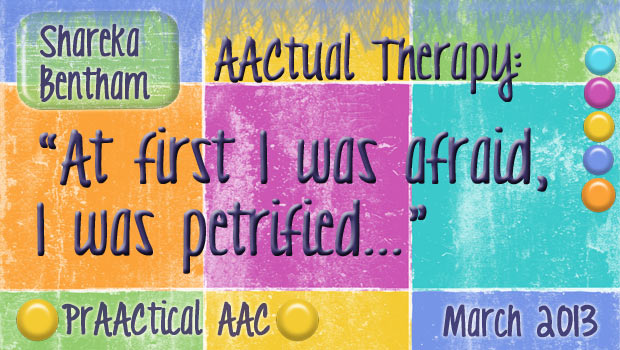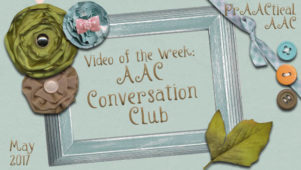AACtual Therapy: “At first I was afraid, I was petrified…”

We’re back to share more from SLP Shareka Bentham whose enthusiasm for providing AAC services to children in Barbados is infectious. If you’ve read any of her previous posts, you’ll know why we appreciate her perspective. Today, Shareka shares some of what she’s learned through starting AAC groups.
Groups can be daunting for many Speech & Language Therapists. They sure were for me for many years. So to make the decision to start an AAC group was more than out of my comfort zone, especially as a beginning AAC therapist. However I think that it has been a great decision so far, as the changes that I have been seeing in the children, parents, and in myself as a therapist have been extremely encouraging.
As I keep stressing I am by no means an AAC expert, but I’m an expert in reflection. I have been able to review each session, think about what  went well and what was an absolute mess (Yes, that happens, too), and use these tips for planning future sessions. I thought I would share a few of these ideas in this post, for therapists who are interested in trying something new and need some tips for some fun, functional group sessions with parents and children.
went well and what was an absolute mess (Yes, that happens, too), and use these tips for planning future sessions. I thought I would share a few of these ideas in this post, for therapists who are interested in trying something new and need some tips for some fun, functional group sessions with parents and children.
Each AAC group will not be the same, as we still need to look at the individual needs of each child and how these will contribute to/ affect the group dynamic. I would suggest keeping the numbers low to allow for a comfortable setting with greater ease of interaction, more opportunities for communication, and a better ability to learn how each child is functioning within the group. I find that these tend to get lost in larger groups in general. My group is made up of 4 children, at the special school where I work, all of whom would be considered ‘low functioning.’ They are all emerging communicators and beginning AAC users, and the focus of the group is building communication through those early cause and effect interactions. Another important objective is for the parents to become familiar and comfortable with using an AAC system to interact with their children. This is a huge shift in thinking for parents, which we tend to underestimate as therapists when we introduce devices, which leads me to my first learning step:
Communicate with parents! These are going to be your children’s main AAC partners, and will most likely be the ones who have to show granny, teacher, and everyone else how this funny looking device helps ‘Mary’ to communicate. So they need to be well informed. Explain everything to them, even those things you may think are very basic, and keep reinforcing these points throughout the session, while showing examples. I like to talk about my goals for the session before we get started, discuss the types of activities we will engage in and talk about some of the vocabulary that will be used. I also try to do some coaching and give specific feedback throughout the session (e.g. I love how you said “you want the bus” everytime he touched the symbol”, or “Do you see how she is now looking at you with anticipation after she pushed the button?”). There is also time at the end of the group for feedback and questions, and recommendations for home use. I want by the end of each session for parents to not only have the knowledge and skills to use the device, but to actually be empowered to use it at home throughout the week.
Plan Ahead! Ahem…I admit that I may be a bit of a last minute person sometimes, but remember earlier when I spoke about what can make sessions a complete mess? Failure to plan effectively for the group is one of those key things (trust me on this one). It is essential to know what activities you will be doing, have the visuals for each activity handy, and also for additional vocabulary which may be useful. For example, being pushed on a swing may not only require a visual for the swing, and words like “push”, “more”, “stop” “go” may come into play. Knowing what type of device(s) you will be using for each session is also essential and how you will be using these devices. Initially I started by using one device for an activity and passing it around in turns to each child, but I found that having a device for each child provided more turns and more opportunities for each child to communicate. This ties in with my next tip:
Provide as many opportunities as possible for each child to use the device to communicate. This may be, as mentioned before, giving each child their own device, or choosing activities that can have lots of repetition (movement activities are great for repetition). I found also that I had to modify some songs to get as many communication turns as possible. Once you make it seem like the most exciting/fun thing in the world, it won’t get boring, and your participants will become more competent users.
Choose different types of activities. During my groups I try to have at least one interactive song activity, one for people play (e.g. round and round a garden) and/or movement, and one toy/object play activity. I also tend to vary the setting each week (e.g. indoors, the playpark etc.). This allows parents and children to see how AAC can be used across a range of settings, and for so many different types of activities. I have found that this has helped parents to relax and be more open generally to using the devices at home.
Be enthusiastic and have fun! Batteries may fail, devices may accidentally fall into the water, you may lose a couple symbols along the way, but if nothing else, make sure that throughout your group session you don’t lose the fun. The participants in your group are going to feed off of your enthusiasm, and when the parents start jumping around, giving high fives, and sounding a lot like you, that’s a good session. The whole concept of AAC use can be a bit scary for even us as therapists, so imagine how it must feel for parents and children. Creating an environment which emphasizes, “yes this is something new, but it’s actually pretty awesome… and you’re communicating, how cool is that?” is key to keeping everyone motivated and wanting to do more of that ‘fun AAC stuff’ you’re talking about.
Those are just a few of the things that I have learnt so far as I continue to run these AAC groups. I’d love to hear from readers on some other things that have worked (or haven’t worked) in your group settings. Also for the therapists that are considering dipping their toes in the wonderful world of AAC groups, I say try it out, you won’t regret it. And come back and let us know how it goes!
Filed under: PrAACtical Thinking
Tagged With: AACtual therapy, group, Shareka Bentham
This post was written by Carole Zangari





1 Comment
Enjoyed this post ( as I do all others).At times we have to come out of our comfort zone to do great things…it’s no different with using an AAC device for the first time!